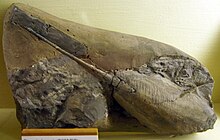Heterostraci
| Heterostraci | ||||||||||||
|---|---|---|---|---|---|---|---|---|---|---|---|---|

Four different heterostraci. |
||||||||||||
| Temporal occurrence | ||||||||||||
| Silurian to Upper Devonian | ||||||||||||
| 430 to 370 million years | ||||||||||||
| Locations | ||||||||||||
|
||||||||||||
| Systematics | ||||||||||||
|
||||||||||||
| Scientific name | ||||||||||||
| Heterostraci | ||||||||||||
| Lankester , 1868 |
The Heterostraci are a group of extinct, fish-like, armored vertebrates and known from fossils from sediments of the Silurian and Devonian . Locations are in North America, Europe and Siberia. Most of the 300 or so known species were marine, but lived in the shallow waters of lagoons and estuaries. Some may also have lived in fresh water. They reached lengths of 5 to 30 centimeters; Representatives of a group of Heterostraci, the Psammosteidae, were significantly larger with up to 150 centimeters.
features
Most Heterostraci were small to medium-sized and reached body lengths of 5 to 30 cm, but the representatives of the Psammosteidae could be up to 1.5 m long. Usually their bodies were fusiform, but there were also broad, dorsoventrally flattened, and even frying pan-shaped shapes. All Heterostraci were heavily armored, the head and front body by bone plates, the rear body and tail by scales. The bone armor consisted of one or more dorsal shields, large ventral shields and a cornual and branchial shield on the sides. There were some smaller plates (oral plates) around the mouth opening. The dorsal and ventral shields were traversed by a branched, straight, curved or zigzag-shaped system of lateral lines that were connected to the surrounding water through rows of pores. The inside of the bone plates was smooth and shiny, no attachment points for an inner skeleton were found. In contrast to the Arandaspida , Astraspida and Eriptychiida , the Heterostraci only had one outer gill opening per head side. In the Amphiaspidida , a Lower Devonian group whose fossil remains were found in Siberia, all bone plates were fused together, formed a completely rigid armor and made the front part of the body immobile. In younger representatives, the carapace was more mobile and the large bone plates were separated from one another by gaps in which there were small plates called "tesserae". The bone plates were layered with a basal layer, a spongy middle layer of acellular bone (aspidin) and an ornamented outer layer on which tubercles and ridges of dentin (dentin) found.
The internal anatomy is only partially known. The heterostraci had two nostrils, which is like the hagfish opened down two vertical semicircular canals , at least 8 gills bags and a three-part brain. The lateral orbits were small. Paired fins, dorsal and anal fins were not present. The inside of the tail was hypocercial and generally more or less fan- or spade-shaped and approximately symmetrical, or the lower lobe was larger. The Heterostraci must have been awkward due to the weight of the bone armor and probably spent much of their lives lying on the ground.
Internal system

Most heterostraci can be assigned to two main clades, which in Nelson have the rank of orders, the
- Cyathaspidiformes (Silurian to Lower Devonian ) and the
- Pteraspidiformes (late Silurian to Upper Devonian)
which are probably in a sister group relationship to one another.
Some other taxa such as Cardipeltida , Corvaspidida , Lepidaspidida , Tesseraspidida , Tolypelepida (also called Tolypelepidida) and Traquairaspidiformes are more or less close to the Heterostraci and their affiliation and exact systematic position is controversial.
literature
- Michael J. Benton : Paleontology of the vertebrates. 2007, ISBN 3-89937-072-4
- Robert L. Carroll: Paleontology and Evolution of the Vertebrates , Thieme, Stuttgart (1993), ISBN 3-13774-401-6
- Oskar Kuhn: The prehistoric fish and fish , A. Ziemsen Verlag, 1967, Wittenberg
- John A. Long: The Rise of Fishes . The Johns Hopkins University Press, 1995, ISBN 0-80184-992-6
- Joseph S. Nelson : Fishes of the World . John Wiley & Sons, 2006, ISBN 0-471-25031-7
- Hans-Peter Schultze: Pteraspidomorphi pages 183-184 in: Wilfried Westheide & Reinhard Rieger: Special Zoology Part 2: Vertebrae and Skull Animals , 1st edition, Spectrum Academic Publishing Heidelberg • Berlin, 2004, ISBN 3-8274-0307-3
Web links
- Philippe Janvier. 1997. Heterostraci. in The Tree of Life Web Project
- Palaeos: heterostraci
- The Paleobiology Database: Heterostraci